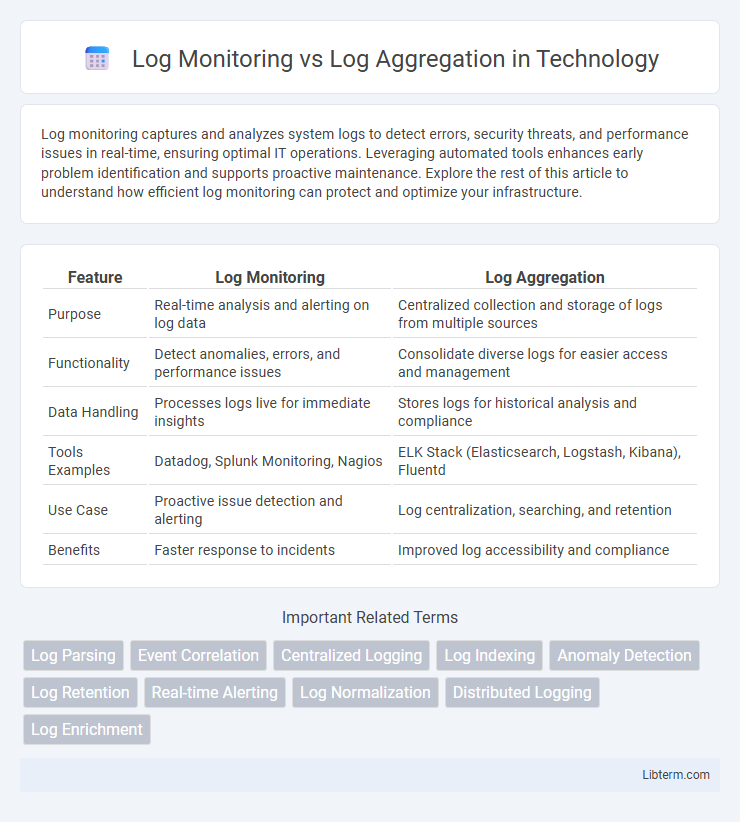Log monitoring captures and analyzes system logs to detect errors, security threats, and performance issues in real-time, ensuring optimal IT operations. Leveraging automated tools enhances early problem identification and supports proactive maintenance. Explore the rest of this article to understand how efficient log monitoring can protect and optimize your infrastructure.
Table of Comparison
| Feature | Log Monitoring | Log Aggregation |
|---|---|---|
| Purpose | Real-time analysis and alerting on log data | Centralized collection and storage of logs from multiple sources |
| Functionality | Detect anomalies, errors, and performance issues | Consolidate diverse logs for easier access and management |
| Data Handling | Processes logs live for immediate insights | Stores logs for historical analysis and compliance |
| Tools Examples | Datadog, Splunk Monitoring, Nagios | ELK Stack (Elasticsearch, Logstash, Kibana), Fluentd |
| Use Case | Proactive issue detection and alerting | Log centralization, searching, and retention |
| Benefits | Faster response to incidents | Improved log accessibility and compliance |
Introduction to Log Monitoring and Log Aggregation
Log monitoring involves real-time analysis and tracking of log data to detect anomalies, errors, and security threats, ensuring system reliability and performance. Log aggregation collects and centralizes log files from multiple sources into a single repository for streamlined access, storage, and analysis. Both processes are essential for effective IT infrastructure management, with monitoring focusing on active issue detection and aggregation enabling comprehensive data consolidation.
Defining Log Monitoring
Log monitoring involves continuously tracking and analyzing log data to detect anomalies, security threats, and system performance issues in real time. It enables IT teams to proactively respond to incidents by setting alerts based on specific log patterns or thresholds. Unlike log aggregation, which centralizes log data from multiple sources for storage and management, log monitoring focuses on immediate analysis and actionable insights.
Defining Log Aggregation
Log aggregation is the process of collecting and centralizing log data from multiple sources into a single repository for easier access and analysis. It enables efficient storage, indexing, and retrieval of large volumes of logs generated by distributed systems, applications, and infrastructure components. Unlike log monitoring, which focuses on real-time analysis and alerting, log aggregation emphasizes comprehensive log data consolidation to support troubleshooting, auditing, and long-term insight generation.
Key Differences Between Log Monitoring and Aggregation
Log monitoring involves real-time analysis and alerting based on log data to detect issues, while log aggregation centralizes log data from multiple sources into a single repository for easier access and management. Monitoring emphasizes proactive identification of anomalies and performance trends, whereas aggregation focuses on collecting and storing logs for comprehensive historical analysis and compliance. Key differences include the immediacy of log monitoring for incident response versus the broad data consolidation role of log aggregation in supporting long-term insights.
Benefits of Log Monitoring
Log monitoring enables real-time analysis and alerting on log data, improving system reliability and accelerating incident response. It allows for proactive detection of anomalies and security threats by continuously tracking log patterns across various applications and infrastructure. This targeted insight reduces downtime and enhances operational efficiency compared to passive log aggregation, which primarily centralizes log storage without immediate analysis.
Benefits of Log Aggregation
Log aggregation consolidates log data from multiple sources into a centralized platform, enabling faster and more efficient analysis compared to isolated log monitoring. It enhances real-time visibility, reduces troubleshooting time, and improves security by correlating events across distributed systems. Centralized log aggregation supports scalability and compliance management by maintaining structured, searchable, and long-term log storage.
Challenges in Log Monitoring vs Log Aggregation
Log monitoring faces challenges such as handling high-volume, real-time streaming data that demands immediate analysis to detect anomalies or failures, often requiring advanced alerting mechanisms. Log aggregation struggles with unifying diverse log formats and sources, ensuring data consistency, and managing storage scalability to maintain quick access for analytics. Both processes demand robust infrastructure, but monitoring prioritizes timely insights while aggregation emphasizes comprehensive data collection and organization.
Use Cases: When to Use Each Approach
Log monitoring is essential for real-time analysis and alerting in security incident detection, system performance tracking, and troubleshooting application errors. Log aggregation is best used for centralized storage, historical analysis, and compliance reporting by collecting logs from multiple sources into a single repository. Use log monitoring when continuous, immediate insight into system behavior is needed, and choose log aggregation for comprehensive log management and long-term data accessibility.
Best Practices for Implementing Log Solutions
Effective log monitoring requires real-time analysis and alerting on critical events to quickly identify and resolve issues, while log aggregation involves centralizing logs from multiple sources for comprehensive visibility and easier management. Best practices include setting clear retention policies, ensuring proper log formatting and tagging, and implementing scalable infrastructure for both monitoring and aggregation to handle increasing log volumes efficiently. Regularly refining filters and alert thresholds helps reduce noise and improves the accuracy of incident detection in log solutions.
Choosing the Right Tool for Your Logging Needs
Choosing the right tool for your logging needs depends on understanding the distinction between log monitoring and log aggregation; log monitoring involves real-time analysis and alerting on log data to detect anomalies, while log aggregation collects and centralizes logs from multiple sources for easier management and searchability. Effective log monitoring tools like Datadog or Splunk offer advanced analytics and alerting capabilities crucial for incident response, whereas log aggregation solutions such as Elasticsearch or Graylog optimize storage and retrieval of large volumes of log data. Evaluate your organization's requirements for real-time insights versus centralized log management to select a solution that balances performance, scalability, and usability.
Log Monitoring Infographic

 libterm.com
libterm.com